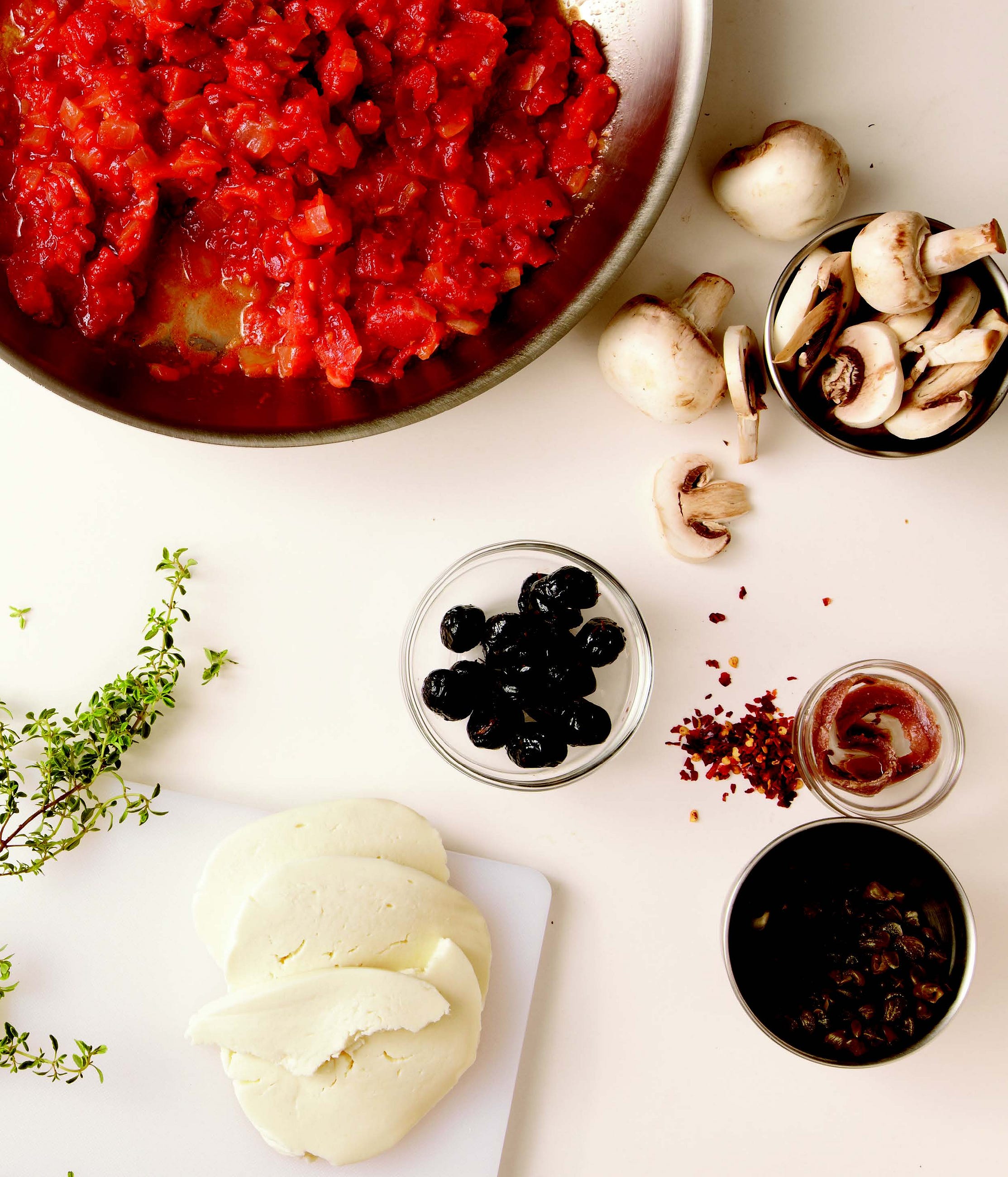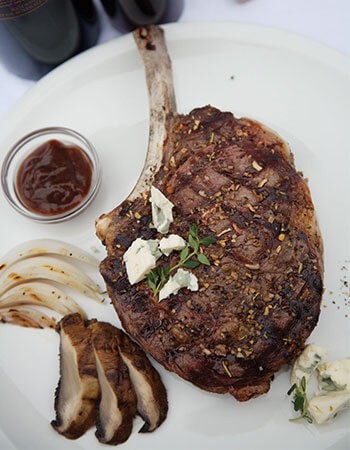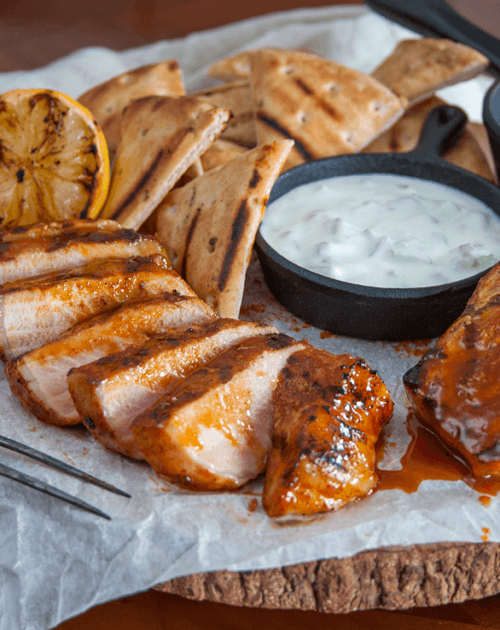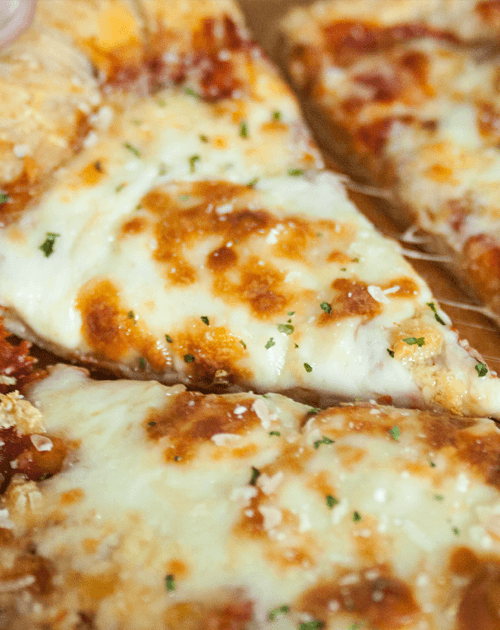9 Tomato Sauce Variations
Keep this handy

You can whip up a batch of tomato sauce from scratch in the time it takes to boil water and cook pasta. Diced tomatoes are super convenient, whether in cans, cartons, or jars. Just don’t buy crushed tomatoes or tomato puree, which are both much too watery.
Canned whole tomatoes will give you an even meatier sauce and are easy enough to deal with: First, drain off the liquid from the can and save it; you may need it to thin the sauce. Don’t bother to core them, but do use a knife to hack away at the tomatoes right in the can to break them up a bit.
Try one of these variations on the main tomato sauce recipe, below.
Tomato Sauce with Fresh or Dried Herbs
Stir any of the following herbs into the sauce just before serving: ¼ to ½ cup chopped fresh basil, parsley, dill, or mint; 10 fresh sage leaves; 1 tablespoon chopped fresh rosemary, oregano or marjoram (or 1 teaspoon dried); 2 teaspoons chopped fresh thyme (or ½ teaspoon dried); or ½ teaspoon chopped fresh tarragon (or ¼ teaspoon dried).
Vegetable-Tomato Sauce
Chop up whatever leftover vegetables you have and warm them up in the sauce just before serving. If you don’t have anything handy, chop 2 cups raw eggplant, zucchini, cauliflower, broccoli, or bell peppers. In Step 1, cook them alone in the oil until the vegetables are soft and tender, 10 to 15 minutes; add more oil to the pan if it starts to look too dry. Remove the vegetables with a slotted spoon, then add the onion to the pan and continue with the recipe. When the sauce is almost done, stir the vegetable back in just long enough to heat through.
Spicy Tomato Sauce
Known as arrabbiata. Skip the onion and put 1 tablespoon chopped garlic in the oil along with 1, 3, or 5 small dried red chiles or a big pinch of crushed red pepper. Cook, stirring, until the garlic is brown — deeply colored but not burned — then turn off the heat for a minute, add the tomatoes, and proceed. Remove the whole chiles before serving.
Tomato Sauce with Fresh Mushrooms
Cook 1 pound sliced trimmed mushrooms (any kind) along with the onion until they shrink and all their liquid evaporates, 5 to 10 minutes; then add the tomatoes and proceed with the recipe.
Cheesy Tomato Sauce
Right before serving, stir in 1 cup cubed fresh mozzarella cheese or use ½ cup ricotta or goat cheese for a creamier, milder sauce.
Puttanesca Sauce
Skip the onion and put about 1 tablespoon chopped garlic in the oil along with a few oil-packed anchovies. Mash the anchovies a bit as you stir; wait to add salt until the sauce is done. Just before adding the tomatoes, stir in 2 tablespoons drained capers, a pinch of red pepper flakes if you like, and ½ cup pitted, oil-cured black olives.
Meaty Tomato Sauce
Start by cooking up to 1 pound ground beef, pork, lamb, chicken, or turkey with the oil and onion until it browns, 5 to 10 minutes, before adding the tomatoes. You can also use sausage; just break it up into chunks as it cooks. Adjust the heat so the meat browns without burning.
Tomato Sauce with Seafood
When the sauce is ready, stir in up to 1 pound peeled shrimp, lump crabmeat, or chopped, cleaned squid, or scallops. Reduce the heat, so it bubbles gently, cover, and cook until the seafood is warmed or cooked through as necessary, 1 to 5 minutes. Or add a 6-ounce can of oil-packed tuna to the pan when you add the tomatoes.
Fresh Tomato Sauce
This takes a few minutes longer to prepare than canned. For a meatier sauce, use Roma (plum) tomatoes; slicing tomatoes have a brighter taste and thinner texture. Cherry tomatoes are fine if you cut them in half and don’t mind the chewiness of the skins, but they’ll never quite come together into the sauce the same way. In any case, figure about 2 pounds per recipe. I don’t bother to peel or seed them, but I do remove the cores. If you want to get rid of the seeds: Cut them in half — lengthwise if they’re Roma; around the equator, if they’re slicers — and gently squeeze out the watery interior. Then cut them into 1-inch chunks and proceed with the recipe.
Now, on to the main recipe.
How to Cook Pasta
Here’s your refresher
heated.medium.com
Pasta with Tomato Sauce
Time: 25 to 30 minutes
Makes: 4 servings
Ingredients
- Salt
- 3 tablespoons olive oil, or more as needed
- 1 medium onion, chopped
- One 28-ounce can diced tomatoes, including the juice
- Freshly ground black pepper
- 1 pound any dried pasta
- ½ cup freshly grated parmesan cheese, plus more for serving
- ½ cup chopped fresh basil leaves for garnish, optional
Instructions
- Bring a stockpot of water to a boil and salt it. Put the oil in a large skillet over medium-high heat. When it’s hot, add the onion. Cook, stirring occasionally, until soft, 2 to 3 minutes. Add the tomatoes and sprinkle with salt and pepper.
- Adjust the heat, so the sauce bubbles enthusiastically and cook, stirring occasionally until the tomatoes break down and the mixture begins to thicken and appear more uniform in texture, 10 to 15 minutes. Taste, adjust the seasoning, and adjust the heat, so the tomato sauce stays hot but doesn’t boil.
- When the water boils, cook the pasta until it is tender, but not mushy; start tasting after 5 minutes. When it’s done, scoop out and reserve at least 1 cup of the cooking water, then drain the pasta.
- Add the pasta and a splash of the cooking water to the sauce in the skillet and toss to coat, adding a little more cooking water or oil if necessary to create a slightly creamy sauce. Taste and adjust the seasoning and add more oil if you’d like. Then toss with the cheese and the basil if you’re using it. Serve, passing more cheese at the table.
- Here’s how to make extra sauce for the freezer: Complete the sauce through step 2, doubling the amounts of oil, onions, tomatoes, and salt and pepper. Let half of the sauce cool and pack it in sealed containers and freeze. Eat within 6 months or so. To defrost, heat it slowly in a pan over low heat, let it sit overnight in the fridge, or microwave it.






